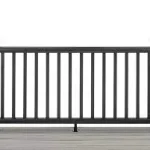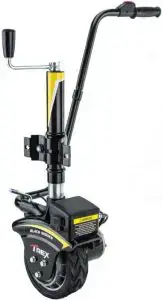
TREX 12V Motorised Trailer Jockey Wheel User Manual

Safety
Safety messages are designed to alert you to possible dangers or hazards that could cause death, injury or equipment or property damage if not understood or followed. Safety messages have the following symbols:
![]() You WILL be KILLED or SERIOUSLY INJURED if you do not follow instructions.
You WILL be KILLED or SERIOUSLY INJURED if you do not follow instructions.
It is vital that you read and understand this user manual before using the product, including safety warnings, and any assembly and operating instructions. Keep the manual for future reference. Safety precautions and recommendations detailed here must be fully understood and followed to reduce the risk of injury, fire, explosion, electrical hazard, and/or property damage. Safety information presented here is generic in nature some advice may not be applicable to every product. The term “equipment” refers to the product, be it electrical mains powered, battery powered or combustion engine powered.
- Before Use – If you are not familiar with the safe operation/handling of the equipment, or are in any way unsure of any aspect of suitability or correct use for your application, you should complete training conducted by a person or organization qualified in safe use and operation of this equipment, including fuel/electrical handling and safety
- Do NOT operate the equipment in flammable or explosive environments, such as in the presence of flammable liquids, gases or dust. The equipment may create sparks or heat that may ignite flammable substances.
- Keep clear of moving parts.
- Equipment may be a potential source of electric shock or injury if misused.
- Do NOT operate the equipment if it is damaged, malfunctioning or is in an excessively worn state.
- Do NOT allow others to use the equipment unless they have read this manual and are adequately trained.
- Keep packaging away from children risk of suffocation! Operators must use the equipment correctly. When using the equipment, consider conditions and pay due care to persons and property.
General Work Area Safety
- Work areas should be clean and well it.
- Do not operate the equipment if bystanders, animals etc are within operating range of the equipment or the general work area.
- If devices are provided for connecting dust extraction / collection facilities, ensure these are connected and used properly. Dust collection can reduce dust-related hazards.
![]() You Can be KILLED or SERIOUSLY INJURED if you do not follow instruction
You Can be KILLED or SERIOUSLY INJURED if you do not follow instruction
General Personal Safety
- Wear appropriate protective equipment when operating, servicing, or when in the operating area of the equipment to help protect from eye and ear injury, poisoning, burns, cutting and crush injuries. Protective equipment such as safety goggles, respirators, non-slip safety footwear, hard hat, hearing protection etc should be used for appropriate equipment / conditions. Other people nearby should also wear appropriate personal protective equipment. Do not wear loose clothing or jewellery, which can be caught in moving parts. Keep hair and clothing away from the equipment.
- Stay alert and use common sense when operating the equipment. Do not over-reach. Always maintain secure footing and balance.
- Do not use the equipment if tired or under the influence of drugs, alcohol or medication.
- This equipment is not intended for use by persons with reduced physical, sensory or mental capabilities.
General Fuel Safety
- Petrol/fuel/gasoline is extremely flammable keep clear of naked flames or other ignition sources.
- Do not spill fuel. If you spill fuel, wipe it off the equipment immediately if fuel gets on your clothing, change clothing.
- Do NOT smoke near fuel or when refuelling.
- Always shut off the engine before refuelling.
- Do NOT refuel a hot engine.
- Open the fuel cap carefully to allow any pressure build-up in the tank to release slowly.
- Always refuel in well ventilated areas.
- Always check for fuel leakage. If fuel leakage is found, do not start or run the engine until all leaks are fixed.
General Carbon-Monoxide Safety
- Using a combustion engine indoors CAN KILL IN MINUTES. Engine exhaust contains carbon-monoxide a poison you cannot smell or see.
- Use combustion engines OUTSIDE only, and far away from windows, doors and vents.
![]() You can be INJURED if you do not follow instruction or equipment damage may occur
You can be INJURED if you do not follow instruction or equipment damage may occur
General Equipment Use and Care
- The equipment is designed for domestic use only.
- Handle the equipment safely and carefully.
- Before use, inspect the equipment for misalignment or binding of moving parts, loose components, damage or any other condition that may affect its operation. If damaged, have the equipment repaired by an authorised service centre or technician before use.
- Prevent unintentional starting of the equipment – ensure equipment and power switches are in the OFF position before connecting or moving equipment. Do not carry equipment with hands or fingers touching any controls. Remove any tools or other items that are not a part of the equipment from it before starting or switching on.
- Do not force the equipment. Use the correct equipment for your application. Equipment will perform better and be safer when used within its design and usage parameters.
- Use the equipment and accessories etc. in accordance with these instructions, considering working conditions and the work to be performed. Using the equipment for operations different from those intended could result in hazardous situations.
- Always keep equipment components (engines, hoses, handles, controls, frames, housings, guards etc) and accessories (cutting tools, nozzles, bits etc) properly maintained. Keep the equipment clean and, where applicable, properly lubricated.
- Store the equipment out of reach of children or untrained persons. To avoid burns or fire hazards, let the equipment cool completely before transporting or storing. Never place or store the equipment near flammable materials, combustible gases or liquids etc.
- The equipment is not weather-proof, and should not be stored in direct sunlight, at high ambient temperatures or locations that are damp or humid.
- Do not clean equipment with solvents, flammable liquids or harsh abrasives.
- For specific equipment safety use and care, see Equipment Safety.
General Electrical Safety
- Inspect electrical equipment, extension cords, power bars, and electrical fittings for damage or wear before each use. Repair or replace damaged equipment immediately.
- Ensure all power sources conform to equipment voltage requirements and are disconnected before connecting or disconnecting equipment.
- When wiring electrically powered equipment, follow all electrical and safety codes.
- Wherever possible, use a residual current device (RCD).
- High voltage / high current power lines may be present. Use extreme caution to avoid contact or interference with power lines. Electrical shock can be fatal.
General Electrical Safety
- Electrically grounded equipment must have an approved cord and plug and be connected to a grounded electrical outlet.
- Do NOT bypass the ON/OFF switch and operate equipment by connecting and disconnecting the electrical cord.
- Do NOT use equipment that has exposed wiring, damaged switches, covers or guards.
- Do NOT use electrical equipment in wet conditions or in damp locations.
- Do NOT use electrical cords to lift, move or carry equipment.
- Do NOT coil or knot electrical cords, and ensure electrical cords are not trip hazards.
General Service Information
- The equipment must be serviced or repaired at authorised service centres by qualified personnel only.
- Replacement parts must be original equipment manufacturer (OEM) to ensure equipment safety is maintained.
- Do NOT attempt any maintenance or repair work not described in this manual.
- After use, the equipment and components may still be hot allow the equipment to cool and disconnect spark plugs and/or electrical power sources and/or batteries from it before making adjustments, changing accessories or performing repair or maintenance.
- Do NOT make adjustments while the equipment is running.
- Perform service related activities in suitable conditions, such as a workshop.
- Replace worn, damaged or missing warning/safety labels immediately.
Safety Symbols
The product may have safety warning labels attached to it, explained below. Understand the symbols on your product and their meanings. If any stickers become unreadable, unattached etc, replace them.
 Flammable Material Hazard
Flammable Material Hazard
Flammable liquids, gases or substances etc may present. Avoid ignition sources and open flames. Danger of fire.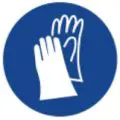 Read User Manual
Read User Manual
Read and fully understand product safety warnings, operation, procedures etc before using the product. Use Hand Protection
Use Hand Protection
Wear appropriate hand protection and take due care as the product or use of the product may present hand hazards. Carbon-Monoxide Hazard
Carbon-Monoxide Hazard
Do not use the product in confined areas or without adequate ventilation. Carbon Monoxide poisoning can be fatal. Electrocution / Electrical Shock Hazard
Electrocution / Electrical Shock Hazard
High voltage or high current electricity may be present or required by the product. Take due care when handling electrical products, cables, plugs and leads. Electrical shock can be fatal. Toxic Fumes / Dust Hazard Using the product or byproducts from use may produce fumes, smoke or particles that could be harmful if inhaled. Wear appropriate breathing protection and have adequate ventilation.
Toxic Fumes / Dust Hazard Using the product or byproducts from use may produce fumes, smoke or particles that could be harmful if inhaled. Wear appropriate breathing protection and have adequate ventilation. Explosive Material Hazard Combustible liquids, gases or substances etc may be present. Avoid ignition source and open flames. Danger of explosion.
Explosive Material Hazard Combustible liquids, gases or substances etc may be present. Avoid ignition source and open flames. Danger of explosion. Cutting / Amputation Hazard The product may have blades, edges or mechanical devices that can cause severe cut injury to fingers, limbs etc. Take due care when handling and using the product.
Cutting / Amputation Hazard The product may have blades, edges or mechanical devices that can cause severe cut injury to fingers, limbs etc. Take due care when handling and using the product.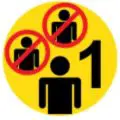 Crush Hazard The product may have blades, edges or mechanical devices that can cause severe crush injury to fingers, limbs etc. Take due care when handling and using the product.
Crush Hazard The product may have blades, edges or mechanical devices that can cause severe crush injury to fingers, limbs etc. Take due care when handling and using the product.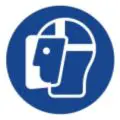 Single Operator Only The product must be operated by a single person only. More than one person operating the product may introduce additional hazards.
Single Operator Only The product must be operated by a single person only. More than one person operating the product may introduce additional hazards.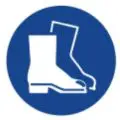 Use Face Protection Wear appropriate full-face protection and take due care as the product or use of the product may present face and eye hazards.
Use Face Protection Wear appropriate full-face protection and take due care as the product or use of the product may present face and eye hazards. Use Foot Protection Wear appropriate foot protection and take due care as the product or use of the product may present foot hazards.
Use Foot Protection Wear appropriate foot protection and take due care as the product or use of the product may present foot hazards. Use Eye / Ear / Head Protection Wear appropriate eye and / or ear and / or head protection and take due care as the product or use of the product may present eye, hearing and head hazards.
Use Eye / Ear / Head Protection Wear appropriate eye and / or ear and / or head protection and take due care as the product or use of the product may present eye, hearing and head hazards.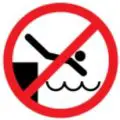 Running Hazard Do not run on or near the product as doing so may present a fall hazard.
Running Hazard Do not run on or near the product as doing so may present a fall hazard.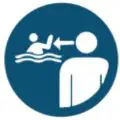 Diving Hazard Do not dive into the product as doing so may present a neck / head injury hazard.
Diving Hazard Do not dive into the product as doing so may present a neck / head injury hazard. Adult Supervision Required Always supervise children and other users of a product to prevent drowning or injury.
Adult Supervision Required Always supervise children and other users of a product to prevent drowning or injury. Skin Penetration / Puncture Hazard The product may produce pressure, emit liquids or objects that can cause severe injury to fingers, limbs, blood etc. Take due care when handling and using the product.
Skin Penetration / Puncture Hazard The product may produce pressure, emit liquids or objects that can cause severe injury to fingers, limbs, blood etc. Take due care when handling and using the product. Hot Surface Hazard Be aware that the product may produce high temperatures and hot surfaces that can cause burn injuries.
Hot Surface Hazard Be aware that the product may produce high temperatures and hot surfaces that can cause burn injuries. Flying Debris Hazard Be aware that the product or use of the product may present hazards produced by flying debris. Wear appropriate clothing and protective devices.
Flying Debris Hazard Be aware that the product or use of the product may present hazards produced by flying debris. Wear appropriate clothing and protective devices. Moving Parts Hazard Be aware that the product contains or uses mechanical devices that move or rotate. Always wait for moving parts to stop fully before handling the product, adjusting, maintenance etc.
Moving Parts Hazard Be aware that the product contains or uses mechanical devices that move or rotate. Always wait for moving parts to stop fully before handling the product, adjusting, maintenance etc. Carbon-Monoxide Hazard Do not use the product in confined areas or without adequate ventilation. Carbonmonoxide poisoning can be fatal.
Carbon-Monoxide Hazard Do not use the product in confined areas or without adequate ventilation. Carbonmonoxide poisoning can be fatal.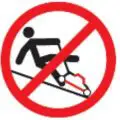 Pull Hazard Be aware that the product contains or uses mechanical devices that can pull in objects and can cause severe injury to fingers, limbs etc. Take due care when handling and using the product.
Pull Hazard Be aware that the product contains or uses mechanical devices that can pull in objects and can cause severe injury to fingers, limbs etc. Take due care when handling and using the product.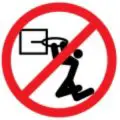 Slope / Fall Injury Hazard
Slope / Fall Injury Hazard
Be aware that using the product on sloping surfaces or in slippery conditions may present additional dangers from falls and contact with blades, moving parts, hot surfaces etc.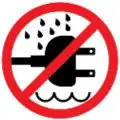 “Slam Dunk” Warning
“Slam Dunk” Warning
Do NOT attempt “slam dunk” maneuvers as this may result in severe injury due to falling, product breakage or collapse etc. Electrocution / Electrical Shock Hazard – Outdoor
Electrocution / Electrical Shock Hazard – Outdoor
High voltage or high current electricity may be present or required by the product. Do NOT use in rain, damp or wet conditions. Electrical shock can be fatal. Electrocution / Electrical Shock Hazard – Disconnect
Electrocution / Electrical Shock Hazard – Disconnect
High voltage or high current electricity may be present or required by the product. Always disconnect the product from the electrical supply before handling the product, adjusting, maintenence etc. Power Line Electrocution Hazard
Power Line Electrocution Hazard
High voltage / high current power lines may be present. Use extreme caution to avoid contact or interference with power lines. Electrical shock, can be fatal.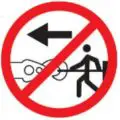 “Kick-Back” Hazard
“Kick-Back” Hazard
High level of “kick-back” hazard that can cause the machine to suddenly rotate towards operator. Kick-back injury can be fatal.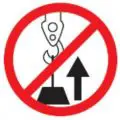 Winch Operator Position Hazard
Winch Operator Position Hazard
Do NOT stand between winch and load. Do NOT use winch to move people.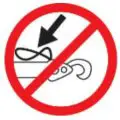 Winch Lift Hazard
Winch Lift Hazard
Do NOT LIFT load vertically. Use machine to PULL only.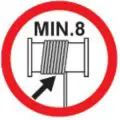 Cable Hazard Ensure that load bearing cable is not kinked or knotted.
Cable Hazard Ensure that load bearing cable is not kinked or knotted. Winch Cable Hazard
Winch Cable Hazard
Ensure that there is a minimum number of cable coils on winching mechanism.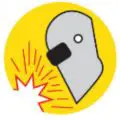 Winch Hook Hazard
Winch Hook Hazard
Carry hook to load do NOT throw or run. Flash / Blinding Hazard Wear appropriate eye protection for welding. Direct exposure to weld arcs may cause permanent eye injury.
Flash / Blinding Hazard Wear appropriate eye protection for welding. Direct exposure to weld arcs may cause permanent eye injury. Laser Hazard
Laser Hazard
Laser may be in use do NOT look directly at laser, or allow others to. Corrosive Substance Hazard
Corrosive Substance Hazard
The product may contain corrosive substances that can harm or otherwise cause damage. Take due care when handling and using the product. Explosion Hazard
Explosion Hazard
The product may contain substances that can explode under certain conditions or misuse. Take due care when handling and using the product.
Equipment Safety
![]() Jockey wheels are high-load bearing and pulling equipment that can cause serious injury if not used correctly or without taking proper safety precautions. It is extremely important that you read and fully understand the information in this section and all other safety warnings / recommendations and usage instructions before using the equipment.
Jockey wheels are high-load bearing and pulling equipment that can cause serious injury if not used correctly or without taking proper safety precautions. It is extremely important that you read and fully understand the information in this section and all other safety warnings / recommendations and usage instructions before using the equipment.
- People with pacemakers should consult their physician before using this product. Operation of electrical equipment in close proximity to a pacemaker could cause interference or failure of the pacemaker.
- The responsibility for safe installation and operation of the jockey wheel and prevention of personal injury and/or property damage rests with you, the operator. There is no substitute for good judgement and caution when using a jockey wheel.
Operator
- If you are untrained in the use of a jockey wheel, it is highly recommended that you be trained/instructed by a suitably qualified or experienced user before using the tool.
- Always keep hands and fingers away from moving parts of the tool when applying or releasing a load. Do NOT stand in front of the load when moving it.
- Read and understand all instructions and safety precautions in the user manual for the object being moved. Make sure to attach the jockey wheel to the manufacturer’s recommended attachment point.
Clothing and Protective Equipment All Operators and Assistants
- Always wear protective gloves and steel cap boots.
Work Area Safety
- Always examine the tool for cracks, deformation, damage, corrosion, and any other condition that may affect the safe operation of the tool. Do not use the tool even if minor damage is seen.
- Keep children away from work area. Do not allow children to handle or use the jockey wheel.
- Never allow any person to be close to the jockey wheel when it is being loaded. Always stand to the side when moving a load NEVER in front of the load.
- Be sure the jockey wheel is correctly and safely mounted to the trailer before operation.
- Do NOT use the jockey wheel if the surface is too slippery for the tyre to grip and drive correctly.
- Do NOT allow the tool to be submerged or exposed to water.
· - Do not alter or weld any part of the jockey wheel. Such alterations may weaken the structural integrity of the tool and will void warranty.
Operational Safety
- Do NOT exceed the maximum rated direct load capacity or load pulling capacity of the tool.
- Always observe the jockey wheel when in use if you notice any change in the position of the jockey wheel when it is under load, STOP using the tool immediately and remove the load.
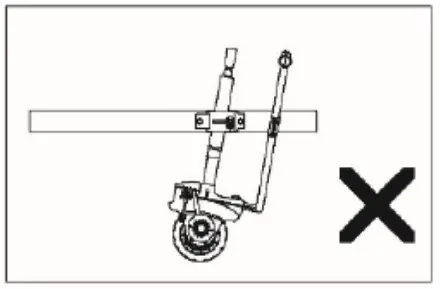
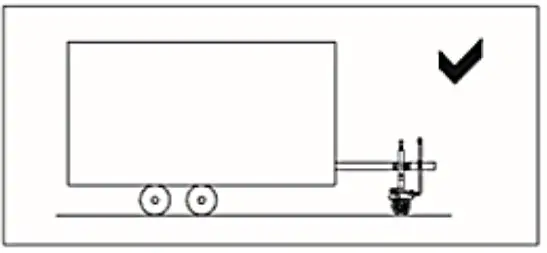
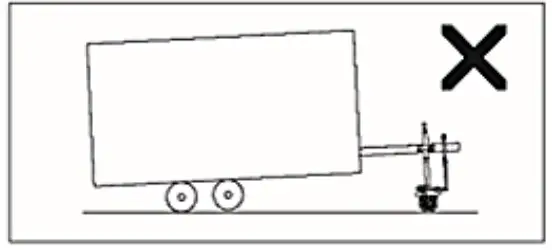
- Do not attempt prolonged movement of heavy loads. The tool is designed for intermittent use only, and should not be used in a constant duty application. The duration of the pulling job should be kept as short as possible. If the jockey wheel motor gets very hot, stop the moving operation and let it cool down for several minutes. Never pull for more than one minute continuously at or near the rated load.
- Do NOT move a load with people in it.
- Do not the jockey wheel as a “jack” the jockey wheel is designed for horizontal movement only. Do NOT use the jockey wheel to lift the load any more than necessary.

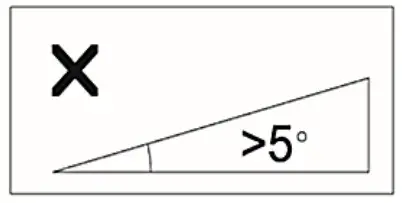
- Do NOT use on inclines greater than 5°.
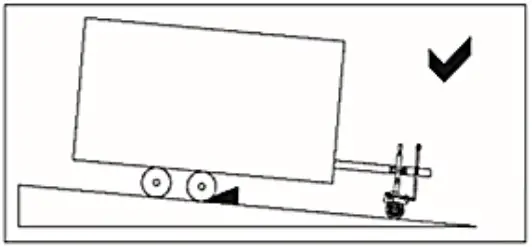
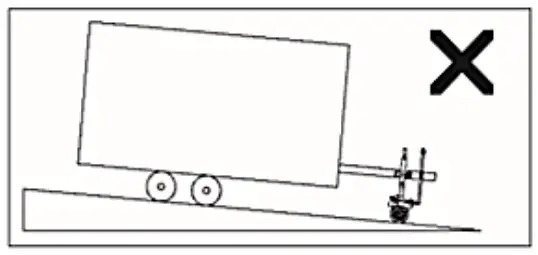
- When using the tool on inclines, it is recommended to use wheel chocks in a manner that helps reduce the risk of the load moving due to the incline
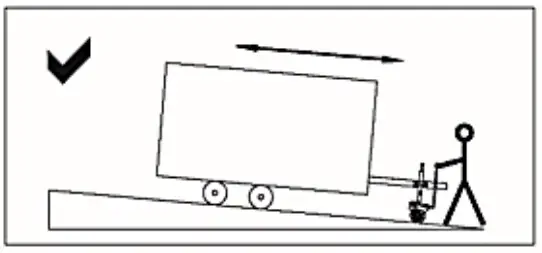
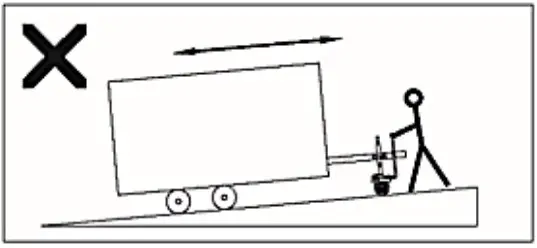
- When using the tool on inclines, always ensure that the jockey wheel is at the lowest point.
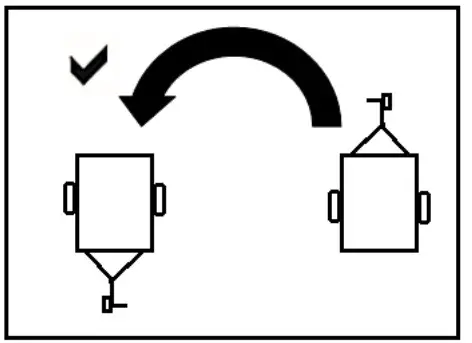
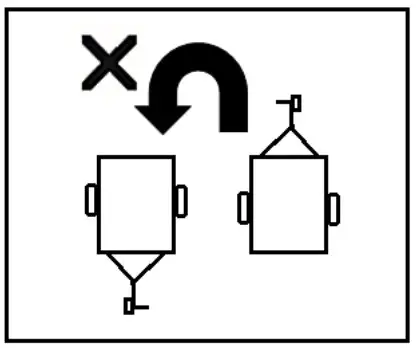
- When turning a load, use the largest possible radius. Sharp turning can overload the tool and possibly damage it (for example, tyre being damaged or pulled from the rim)
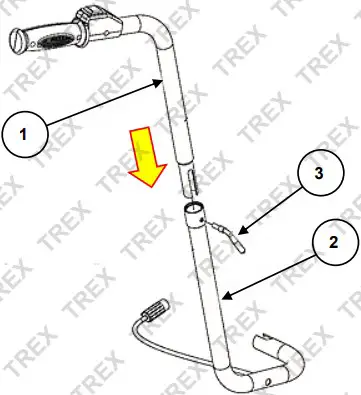
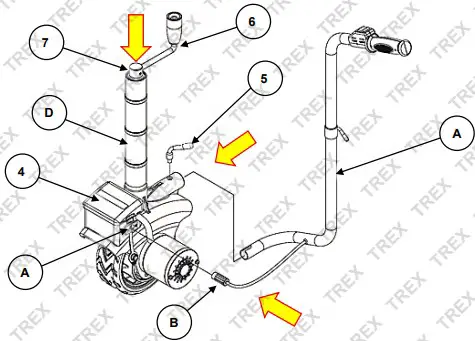
- Do not cross over or under the cable when the winch is being loaded
- Ensure that the battery used to power the tool is 12V and has a minimum capacity of 18Ah. Ensure that the battery is sufficiently charged before use.
- After use, release the load, disconnect the jockey wheel from the battery and remove the tool.
- Do not leave the jockey wheel unattended while it is under load. · Always operate the jockey wheel with an unobstructed view of the moving operation.
- Always DISCONNECT the jockey wheel power leads to battery before working in or around the jockey wheel so that the winch cannot be turned on accidentally.
- Do NOT connect the tool to a 240VAC mains electrical supply.
Assembly and Installation
- Slide the upper handle (1) into the lower handle (2) and secure the parts with the MS locking screw (1) Be careful not to damage or pinch the electrical wires when joining the parts.
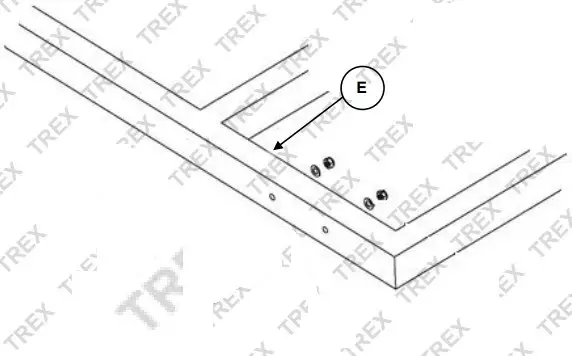
- Slide the bottom tube of the assembled handle (A) into the main housing (6) and secure the parts with the M14 locking screw (5)
- Connect the handle assembly cable (8) to the connector (C) in the main housing.
- Place the jacking handle (6) on the shaft at the top of the jockey wheel post (D) and secure it to the shaft using the bolt and nut (7).
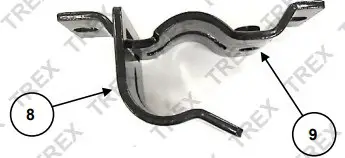
- Hook the latch pressure plate (8) onto the latch plate (9). then attach the latch plate to the trailer (E) using 2 M12 bolts, washers and nuts (10). You may have to drill suitable holes in the trailer for the bolts to pass through.


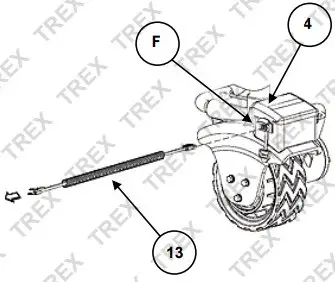
- Place the jockey wheel post (D) Into position in the latch so that the latch is in-between the ridges on the post, then close the pressure plate over the post. Secure the latch plate using the pin (11) and frmly tighten using a suitable spanner. Slide the lock (12) over the pin to help prevent theft
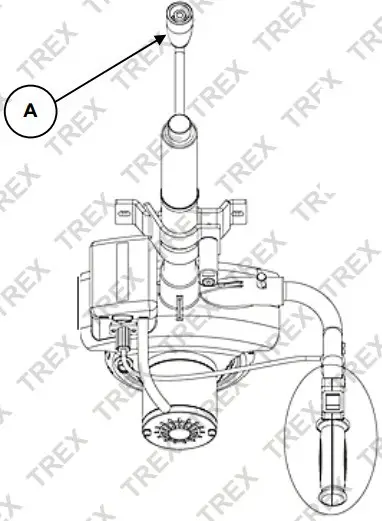
- Connect the power cable (13) to the connector (F) in the jockey wheel main housing (4). then connect the other end of the power cable to the battery.To battery
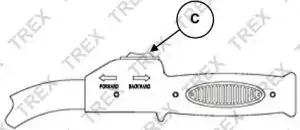
Operation
![]() Jockey wheels are high-load bearing and pulling equipment that can cause serious injury if not used correctly or without taking proper safety precautions. It is extremely important that you read and fully understand the information in this section and all other safety warnings / recommendations and usage instructions before using the equipment.
Jockey wheels are high-load bearing and pulling equipment that can cause serious injury if not used correctly or without taking proper safety precautions. It is extremely important that you read and fully understand the information in this section and all other safety warnings / recommendations and usage instructions before using the equipment.
- The responsibility for safe installation and operation of the jockey wheel and prevention of personal injury and/or property damage rests with you, the operator. There is no substitute for good judgement and caution when using a jockey wheel.
- Ensure the jockey wheel is assembled and installed correctly.
- Rotate the jacking handle (A) to lower the jockey wheel until the trailer is rifted off the ground and the jockey wheel is taking the load. Rotate the handle right (clockwise) to lower the jockey wheel (lift the load): rotate left (anti-clockwise) to raise the jockey wheel (lower the load). Do NOT lift the trailer any more than is necessary.
- Place the jockey wheel ON / OFF switch (B) in the ‘ON’ (“I’) position.
- Press the control switch (C) on the jockey wheel handle (0) to activate the motor. Hold the switch in the ‘FORWARD’ position to drive forward: hold the switch in the “BACKWARD’ position to reverse. Release the switch to stop moving. When finished, place the ON / OFF switch in the ‘OFF (“0”) position. then use the jacking handle to raise the jockey wheel. Disconnect the jockey wheel from the battery. Unlock and remove the latch lock, unscrew and remove the pin, then remove the jockey wheel.



Maintenance and Troubleshooting
![]()
![]() Always release any load from the jockey wheel and disconnect it from the electrical supply before performing any maintenance.
Always release any load from the jockey wheel and disconnect it from the electrical supply before performing any maintenance.
- The toot should be cool enough to touch before performing maintenance activities.
- Wear suitable gloves when handling the tool.
- Some maintenance activities described may be beyond the scope of some users. For procedures that you are not comfortable with or have the knowledge, tools or experience for, have the unit serviced by a service centre or qualified technician.
- Before using the jockey wheel. inspect its general donation. Check for loose screws, misalignment or binding of moving parts, cracked, bent or broken parts and any other condition that may affect its safe operation. Inspect the entire unit for corrosion that may be caused by exposure to saltwater or weather. If abnormal noise or vibration occurs, have the unit inspected and repaired before further use. Do NOT use a damaged or faulty jockey wheel.
- Wipe the tool clean with a soft. damp cloth. If necessary, a mild detergent may be used. Ensure that the electrical connections are dean and free of debris, corrosion etc.
Troubleshooting
| Symptom | Possible Cause | Remedy |
| Motor not operating | No power | Ensure that the battery is compatible. and is sufficiently charged. Ensure that the power and control cables are correctly connected and that all connectors are clean Ensure that the Jockey wheel a switched ON. |
| Over-temperature protection tripped | ||
| Low motor speed | Over-loaded | Stop operation and allow unit to cool for 5-10 minutes. |
| Low battery power | ||
| Wheel sapping | Over-loaded | Reduce load. |
| Incline too great | Do NOT use on inclines over 5′. | |
| Surface too slippery | Use on less slippery surface. | |
| Abnormal noise | Over-loaded | Reduce load. |
Specifications
| Recommended Battery Type | I2VDC / 18Ah minimum capacity |
| Speed | Approximately 6m/min |
| Maximum Inclination | 5 |
| Maximum Pulling Load Capacity | 35008g (7700Ib) |
| Maximum Direct Load | 272kg (60CIb) |
Some experts believe the incorrect o prolonged use of almost any product could cause serious injury or death. For information that may reduce your risk of serious injury or death, consult the points below and additionally, the information available at www.datastreamserver.com/safety
- Consult all documentation. packaging and product labelling before use. Note that some products feature online documertaban which should be printed and kept with the product
- Check product for loose / taken / damaged r missing parts. wear or leaks (if applicable) before each use. Never use a product with looser broken / damaged! missing parts, wear or leaks (if applicable).
- Products must be inspected arc serviced (if applicable) by a qualified specialist every 6 months assuming average residential use by a person of average wept and strength, above average technical aptitude. on a property matching average metropolitan specification. Intended use outside these guidelines could rdcate the product is nzt suitable for intended use or may recluse more regular inspection or servicing.
- Ensure all possible users of the product have completed an industry recognized training cane before being given access to the product.
- The product has been supplied by a general merchandise retailer that may not be fender with your specific application or your description of the aecicatie. Be sure to attain third-party approval for )our application from a qualified specialist before use regardless of pnor assurances by the retailer or its representatives.
- This product is not intended for use where fail-safe operation is required. As with any product (take an automobile. aircraft. computer or ball point pen for example). there is always a small chance of technical issues that needs to be repaired or may require replacement of the product or a part. If the possibility of such failure and the associated time it takes to rectify could in any situation inconvenience the user, business or employee then the product is not suitable for your requirements. This product is not for use where marred operation ct a failure of any kind. including but not limited to a condition requiring product return. replacement. service by a technician or replacement of parts could cause a financial loss. loss of employee totem an inconvenience requiring compensation.
- If Wes item has been purchased in error after considering the points above. steely contact the retailer directly for details of their returns poky. if required
.
